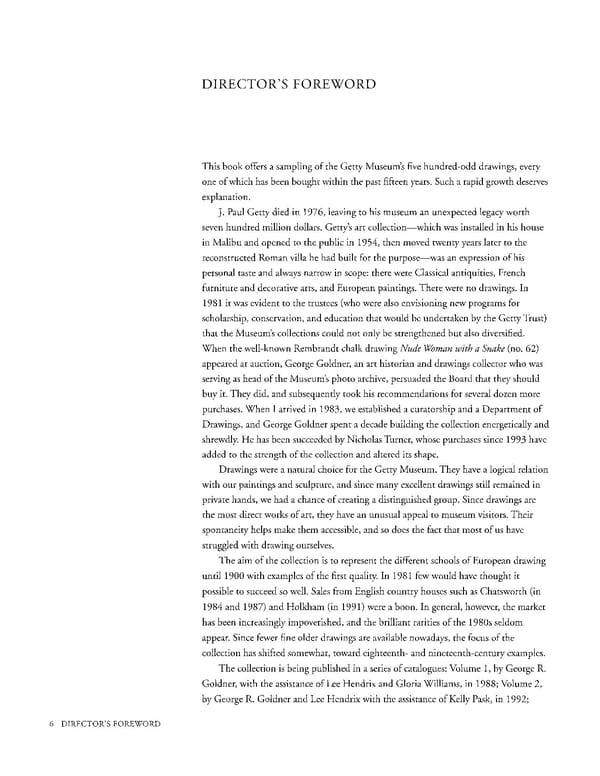DIRECTOR'S FOREWORD This book offers a sampling of the Getty Museum's five hundredodd drawings, every one of which has been bought within the past fifteen years. Such a rapid growth deserves explanation. J. Paul Getty died in 1976, leaving to his museum an unexpected legacy worth seven hundred million dollars. Getty's art collection—which was installed in his house in Malibu and opened to the public in 1954, then moved twenty years later to the reconstructed Roman villa he had built for the purpose—was an expression of his personal taste and always narrow in scope: there were Classical antiquities, French furniture and decorative arts, and European paintings. There were no drawings. In 1981 it was evident to the trustees (who were also envisioning new programs for scholarship, conservation, and education that would be undertaken by the Getty Trust) that the Museum's collections could not only be strengthened but also diversified. When the wellknown Rembrandt chalk drawing Nude Woman with a Snake (no. 62) appeared at auction, George Goldner, an art historian and drawings collector who was serving as head of the Museum's photo archive, persuaded the Board that they should buy it. They did, and subsequently took his recommendations for several dozen more purchases. When I arrived in 1983, we established a curatorship and a Department of Drawings, and George Goldner spent a decade building the collection energetically and shrewdly. He has been succeeded by Nicholas Turner, whose purchases since 1993 have added to the strength of the collection and altered its shape. Drawings were a natural choice for the Getty Museum. They have a logical relation with our paintings and sculpture, and since many excellent drawings still remained in private hands, we had a chance of creating a distinguished group. Since drawings are the most direct works of art, they have an unusual appeal to museum visitors. Their spontaneity helps make them accessible, and so does the fact that most of us have struggled with drawing ourselves. The aim of the collection is to represent the different schools of European drawing until 1900 with examples of the first quality. In 1981 few would have thought it possible to succeed so well. Sales from English country houses such as Chatsworth (in 1984 and 1987) and Holkham (in 1991) were a boon. In general, however, the market has been increasingly impoverished, and the brilliant rarities of the 1980s seldom appear. Since fewer fine older drawings are available nowadays, the focus of the collection has shifted somewhat, toward eighteenth and nineteenthcentury examples. The collection is being published in a series of catalogues: Volume 1, by George R. Goldner, with the assistance of Lee Hendrix and Gloria Williams, in 1988; Volume 2, by George R. Goldner and Lee Hendrix with the assistance of Kelly Pask, in 1992; 6 DIRECTOR'S FOREWORD
 Masterpieces of the Getty Museum: Drawings Page 6 Page 8
Masterpieces of the Getty Museum: Drawings Page 6 Page 8